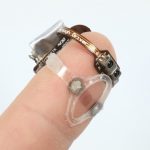The EPFL-LMTS develops:
- Elastomer-based actuators and sensors
- Wearable Haptics and Haptic displays
- MEMS and Printed Microsystems
CURRENT RESEARCH TOPICS
1. Miniaturized Elastomer Actuators
 We are widely recognized for our innovative fabrication techniques and elegant applications of Dielectric Elastomer Actuators (DEAs) and zipping elastomer-based transducers.
We are widely recognized for our innovative fabrication techniques and elegant applications of Dielectric Elastomer Actuators (DEAs) and zipping elastomer-based transducers.
Our focus is on complex soft machines and soft robots.
2. Wearable Haptic Displays
 We develop arrays of low-power flexible actuators for tactile and haptic displays for VR, AR and to allow blind and visually-impaired users to access dynamic graphical information.
We develop arrays of low-power flexible actuators for tactile and haptic displays for VR, AR and to allow blind and visually-impaired users to access dynamic graphical information.
3. MEMS and Printed Microsystems (Dr. Briand)

3.1 Soft sensors and labels
We develop flexible sensors on cellulosic and polymeric substrates for a variety of applications, such as smart packaging, environmental and health monitoring, IoT, wearables and implants. Physical, chemical and biological sensors have been demonstrated and integrated into single or multi-sensing systems incorporating microfluidic, electronic, and wireless functionalities, among others.
3.2 Additive and digital manufacturing of smart objects
We research on additive manufacturing processes with a reduced environmental impact addressing ink formulation, their printing and curing/sintering. Digital 2D printing (i.e. inkjet) and 3D printing (i.e. DIW) enable the customisation of microsystems. 3D structural electronics based on a hybrid approach, embedding together printed and discrete functional components (i.e. Si chips), is also studied.
3.3 Sustainable electronics and microsystems
Additive manufacturing of bio-sourced and renewable materials is a promising approach for the development of greener electronic systems by enabling, after service life, their ecoresorbability and/or recyclability. We are addressing the substitution of non-degradable and difficult to recycle materials to allow either biodegradation or facile recycling, targeting a higher level of circularity.